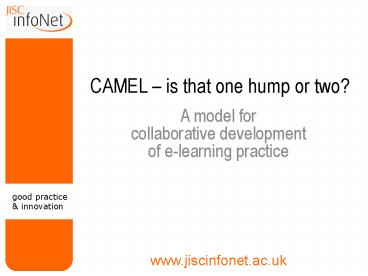CAMEL is that one hump or two - PowerPoint PPT Presentation
1 / 12
Title:
CAMEL is that one hump or two
Description:
CAMEL is that one hump or two – PowerPoint PPT presentation
Number of Views:138
Avg rating:3.0/5.0
Title: CAMEL is that one hump or two
1
CAMEL is that one hump or two?
- A model for collaborative development of
e-learning practice
2
About the Service
Social Software
E-Learning
Learning Spaces
RiskManagement
ProjectManagement
ChangeManagement
Flexible Delivery
E-Portfolios
3
The CAMEL Model
4
The idea
5
Key Features of the Uruguayan Model
- Planned collaboratively
- Documented before and after
- Focused on things which matter
- Expertly facilitated
- Strong emphasis on tacit knowledge and making
this explicit
6
Finding Things Out
7
Who to involve?
You can learn from people who arent your most
obvious peer group that very different
institutions all exhibit good practice
We shared enough in common to make our
differences interesting
It helps in understanding more about the nature
of students coming from FE and what kind of
learning and teaching background they are coming
out of
It has helped colleges see what HE institutions
are looking for in students
8
Enabling Lifelong Learning
- Partnering with industry on course
development - Collaborative ventures with HE schools on
e-portfolios - Simple but effective tools
- Working with a particular industry sector to
save a department from closure - Supporting non-traditional students via
distance learning - Costing e-learning
- Wide range of tools to support distance
learners - Diversity at a local level with central
support - Regional partnerships to share experience
improve practice
- Working with partner colleges sharing
resources - Policies and staff support
- Engaging staff in new practices embedding
e-learning
9
A Subject Focus
10
The e-Learning Spectrum
11
CAMEL Outputs
12
Participant Voices

